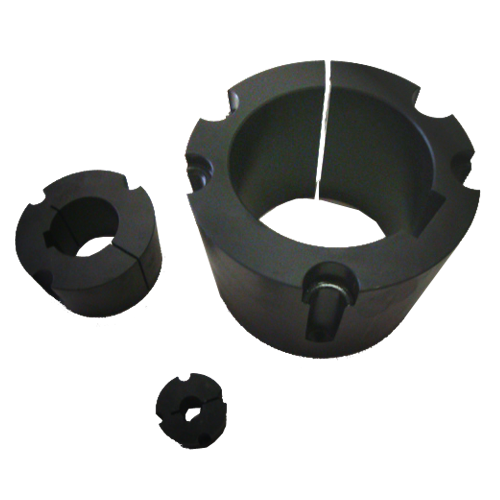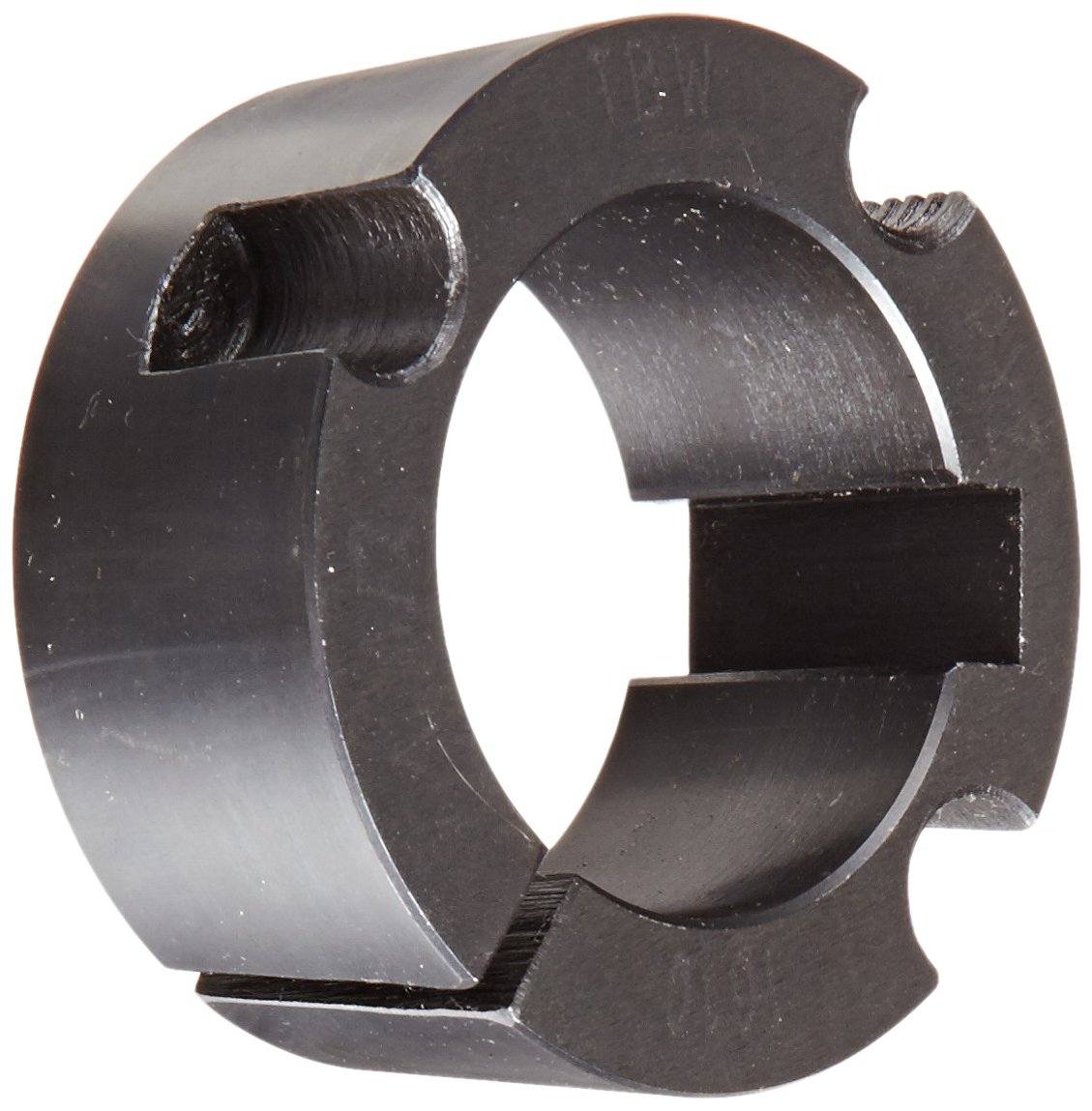Product Description
Product Description
1) Feature of Taper Bushing:
*Easy on-easy off;
*Machined to high precise tolerance;
*A full range of both metric and inch sizes taper bushes are available;
2) Taper Bushings Specification:
| Bushing No. | Bore |
| 1008 | 10.11.12.14.15.16.18.19.20.22.24.25 |
| 1108 | 10.11.12.14.15.16.18.19.20.22.24.25.28 |
| 1210 1215 | 11.12.14.15.16.18.19.20.22.24.25.28.30.32 |
| 1310 | 14.15.16.18.19.20.22.24.25.28.30.32.35 |
| 1610 1615 | 14.15.16.18.19.20.22.24.25.28.30.32.35.38.40.42 |
| 2012 2017 | 18.19.20.22.24.25.28.30.32.35.38.40.42.45.48.50 |
| 2517 2525 | 20.22.24.25.28.30.32.35.38.40.42.45.48.50.55.60 |
| 3571 3030 | 25.28.30.32.35.38.40.42.45.48.50.55.60.65.70.75 |
| 3525 3535 | 35.38.40.42.45.48.50.55.60.65.70.75.80.85.90 |
| 4030 4040 | 40.42.45.50.60.65.70.75.80.85.90.95.100 |
| 4535 4545 | 55.60.65.70.75.80.85.90.95.100.105.110 |
| 5040 5050 | 60.65.70.75.80.85.90.95.100.105.110.115.120.125 |
Detailed Photos
Cast iron taper bushing, phosphated
Carbon steel taper bushing
Each set individually packed
Large stock in warehouse
Catalogue
Packaging & Shipping
Export wooden box
FAQ
Q1: Are you trading company or manufacturer ?
A: We are factory.
Q2: How long is your delivery time and shipment?
1.Sample Lead-times: 10-20 days
2.Production Lead-times: 30-45 days after order confirmed.
Q3: What is your advantages?
1. The most competitive price and good quality.
2. Perfect technical engineers give you the best support.
3. OEM is available.
| Standard Or Nonstandard: | Standard |
|---|---|
| Shaft Hole: | 19-32 |
| Bore Diameter: | 19mm |
| Structure: | Phosphated |
| Material: | Cast Iron |
| Type: | Bushing |
| Customization: |
Available
| Customized Request |
|---|

Are there guidelines for lubricating pulley bushings, and what lubricants are recommended?
Yes, there are guidelines for lubricating pulley bushings, and specific lubricants are recommended to ensure proper operation and longevity of the bushings. Here are some general guidelines and recommendations:
- Manufacturer’s Recommendations: The best source of information on lubricating pulley bushings is the manufacturer of the bushing itself. The manufacturer typically provides guidelines and recommendations regarding the lubrication requirements for their specific bushing products. These recommendations may be available in the product documentation, installation manuals, or technical specifications provided by the manufacturer. It is important to follow the manufacturer’s guidelines to ensure optimal performance.
- Cleanliness: Before lubricating pulley bushings, it is crucial to ensure that the bushings and the surrounding area are clean. Remove any dirt, debris, or old lubricant residues from the bushings and the shaft. Cleanliness helps to prevent contamination and ensures proper lubricant distribution.
- Lubricant Type: The choice of lubricant depends on factors such as the bushing material, operating conditions, temperature, and load. Common lubricant types used for pulley bushings include grease and oil. Grease is often preferred for its ability to provide long-lasting lubrication, while oil may be used for applications with high speeds or specific requirements. It is recommended to consult the manufacturer’s guidelines or contact them directly to determine the appropriate lubricant type for the specific bushing.
- Appropriate Lubricant Grade: Lubricants come in different grades or viscosities, and the appropriate grade depends on the operating conditions. Higher viscosities are generally suitable for heavy-duty applications or higher loads, while lower viscosities are used for lighter loads or high-speed applications. The manufacturer’s recommendations or technical documentation can provide guidance on the appropriate lubricant grade for the specific application.
- Lubrication Interval: Establishing a regular lubrication schedule is important to maintain optimal performance of pulley bushings. The lubrication interval depends on factors such as operating conditions, loads, and the type of lubricant used. Some bushings may require lubrication at specific time intervals or operating hours, while others may have longer intervals. The manufacturer’s recommendations should specify the appropriate lubrication interval.
- Proper Lubrication Method: Follow the recommended lubrication method provided by the bushing manufacturer. This may involve applying the lubricant directly to the bushing, using a grease gun or oiler, or following specific instructions for lubricant application. Proper lubrication method ensures effective distribution of the lubricant within the bushing and minimizes excess or inadequate lubrication.
It is important to note that different pulley bushing manufacturers may have specific lubrication requirements or recommendations. Therefore, consulting the manufacturer’s guidelines, product documentation, or contacting their technical support is crucial to ensure proper lubrication practices for the specific pulley bushings being used.

Can I find information on alternatives to pulley bushings for specific mechanical applications?
Yes, you can find information on alternatives to pulley bushings for specific mechanical applications. Depending on the requirements of your application, there may be alternative solutions that can fulfill similar functions as pulley bushings. Here are some sources where you can find information on alternatives to pulley bushings:
- Engineering Literature and Research Papers: Engineering literature, including research papers and technical journals, often discuss alternative solutions and innovations in various mechanical applications. These sources may highlight alternative components, mechanisms, or design approaches that can replace or supplement pulley bushings. Accessing online databases such as IEEE Xplore, ScienceDirect, or Google Scholar can provide access to a wide range of engineering literature.
- Engineering Forums and Communities: Online engineering forums and communities, such as engineering.stackexchange.com or eng-tips.com, provide platforms for professionals and enthusiasts to discuss and share knowledge on various engineering topics. Participating in these communities, posting specific questions about alternative solutions to pulley bushings, and engaging in discussions with experienced engineers can yield valuable insights and recommendations.
- Manufacturer Documentation and Technical Guides: Manufacturers of mechanical components and systems often provide documentation and technical guides that detail alternative solutions or product options for specific applications. These resources may outline different mechanisms, transmission systems, or design approaches that can be used instead of pulley bushings. Checking the documentation and technical guides of relevant manufacturers or contacting their customer support can provide access to information on alternatives.
- Industry Conferences and Trade Shows: Attending industry conferences and trade shows related to mechanical engineering, manufacturing, or specific industries can expose you to the latest advancements and alternative solutions in mechanical applications. These events often feature presentations, demonstrations, and exhibitions that showcase innovative technologies and products. Engaging with industry experts, networking with professionals, and exploring the exhibits can help you gather information on alternatives to pulley bushings.
- Consulting with Mechanical Engineers or Experts: Consulting with mechanical engineers or experts who specialize in the specific application or industry can provide valuable insights on alternative solutions. These professionals have experience and knowledge in designing and implementing mechanical systems, and they can offer recommendations based on their expertise and familiarity with the latest developments in the field.
When seeking information on alternatives to pulley bushings, it’s important to consider the specific requirements and constraints of your application. Factors such as load capacity, motion control, space limitations, environmental conditions, and cost-effectiveness should be taken into account when evaluating alternative solutions. Combining information from multiple sources and consulting with experts can help you make informed decisions regarding the best alternatives for your specific mechanical application.

What are the key materials used in manufacturing pulley bushings and their advantages?
When it comes to manufacturing pulley bushings, various materials are used, each with its own advantages and suitability for specific applications. Here are some key materials commonly used in the manufacturing of pulley bushings and their advantages:
1. Bronze:
– Bronze is a popular material for pulley bushings due to its excellent durability and self-lubricating properties.
– Bronze bushings can withstand heavy loads and high temperatures, making them suitable for demanding applications.
– They have good resistance to corrosion and wear, making them long-lasting and requiring less maintenance.
2. Steel:
– Steel bushings offer high strength and durability, making them suitable for applications with heavy loads and high-speed operations.
– They have excellent wear resistance and can withstand harsh operating conditions.
– Steel bushings are often used in industrial applications where reliability and longevity are crucial.
3. Stainless Steel:
– Stainless steel bushings are highly resistant to corrosion and rust, making them ideal for outdoor or marine applications.
– They offer good strength and durability, making them suitable for various operating conditions.
– Stainless steel bushings are commonly used in food processing, pharmaceutical, and chemical industries where cleanliness and hygiene are essential.
4. Nylon:
– Nylon bushings are known for their low friction properties, making them self-lubricating and reducing the need for additional lubrication.
– They are lightweight and have good resistance to wear and abrasion.
– Nylon bushings are commonly used in applications where noise reduction and smooth operation are required, such as in office equipment or consumer appliances.
5. Delrin (Acetal):
– Delrin bushings offer low friction, excellent wear resistance, and dimensional stability.
– They have good strength and stiffness, making them suitable for applications with moderate loads and speeds.
– Delrin bushings are often used in automotive, electronics, and machinery industries.
It’s important to note that the choice of material for pulley bushings depends on factors such as the specific application, load requirements, operating conditions, and environmental factors. Different materials offer different advantages, and selecting the appropriate material ensures optimal performance, longevity, and reduced maintenance needs for the pulley system.


editor by CX 2023-12-15